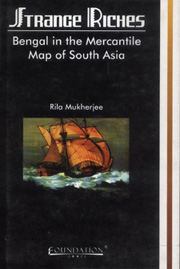Book contents
- Frontmatter
- Contents
- Epigraph
- Preface
- Acknowledgments
- Abbreviations
- Map 1 Places mentioned in Bengal and Arakan: 5th to 13th centuries
- Map 2 Land and sea routes of the Eastern Indian Ocean: 13th to 15th centuries
- 1 Introduction
- 2 Conceptual Formulations
- 3 Key Issues: Bengal
- 4 Introducing Bengal
- 5 The Debated Century
- 6 Networks and States in South Asia
- 7 Unities of Time and Space in Bengal
- 8 Bengal in the Indian Ocean Centred World Economy
- 9 Conclusion
- Bibliography
- Index
7 - Unities of Time and Space in Bengal
Published online by Cambridge University Press: 26 October 2011
- Frontmatter
- Contents
- Epigraph
- Preface
- Acknowledgments
- Abbreviations
- Map 1 Places mentioned in Bengal and Arakan: 5th to 13th centuries
- Map 2 Land and sea routes of the Eastern Indian Ocean: 13th to 15th centuries
- 1 Introduction
- 2 Conceptual Formulations
- 3 Key Issues: Bengal
- 4 Introducing Bengal
- 5 The Debated Century
- 6 Networks and States in South Asia
- 7 Unities of Time and Space in Bengal
- 8 Bengal in the Indian Ocean Centred World Economy
- 9 Conclusion
- Bibliography
- Index
Summary
‘The ground is rich in everything although the waters are bad because the area is entirely covered in swampland. Very long crescent shaped lakes stretch between the palm groves, and all along the shores of these lakes there are houses whose doors open onto the water’ Bouchon, Genevieve and Thomaz, Luis Filipe, ‘Voyage dans les deltas du Gauge et de I'lrraoaddy 1521', Fondation Calouste Gulbenkian, Paris, 1988: 316)
Unities of Time and Space: The Place of Bengal in the History of South Asia
This passage evokes the sense of a littoral land, something we discussed right at the beginning. A land of marshes, salt seas and swamps; Bengal's topography is unique in South Asia. We have already underlined the distinctiveness of her landscape.
We examined the place of Bengal within the overall debate on the eighteenth century in South Asia, and noted that the eighteenth century debate has concerned itself mainly with territorial South Asia. While Bengal's primacy in the eighteenth century is unquestioned readings of the commercial history of Bengal in earlier periods suggest a different engagement with the major trade networks emanating from the ancient period.
How then, did Bengal achieve this pre-eminent economic postion in the eighteenth century? Part of this has already been answered. It was its cheap prices and lack of control over its own resources. But what facilitated the entry of the Europeans into Bengal?
- Type
- Chapter
- Information
- Strange RichesBengal in the Mercantile Map of South Asia, pp. 319 - 345Publisher: Foundation BooksPrint publication year: 2006



